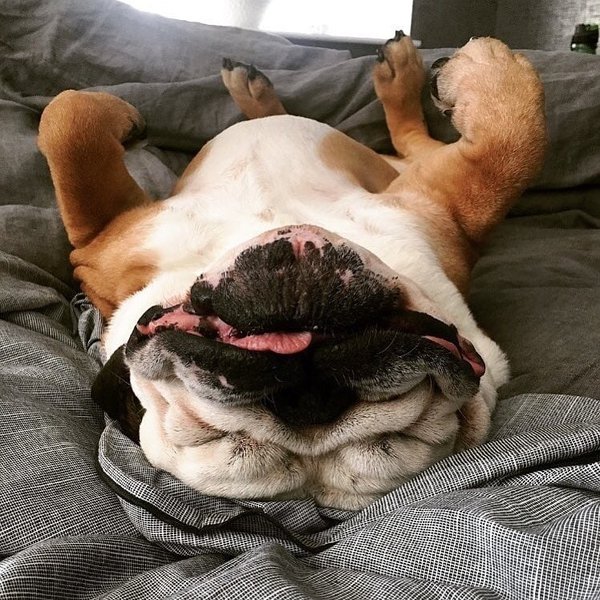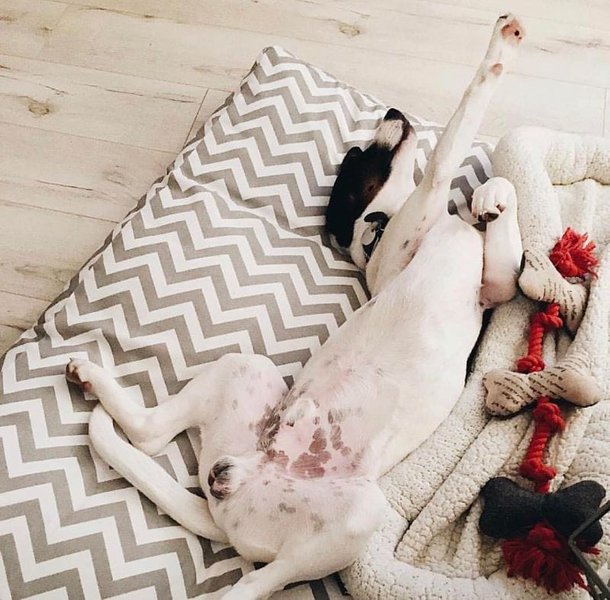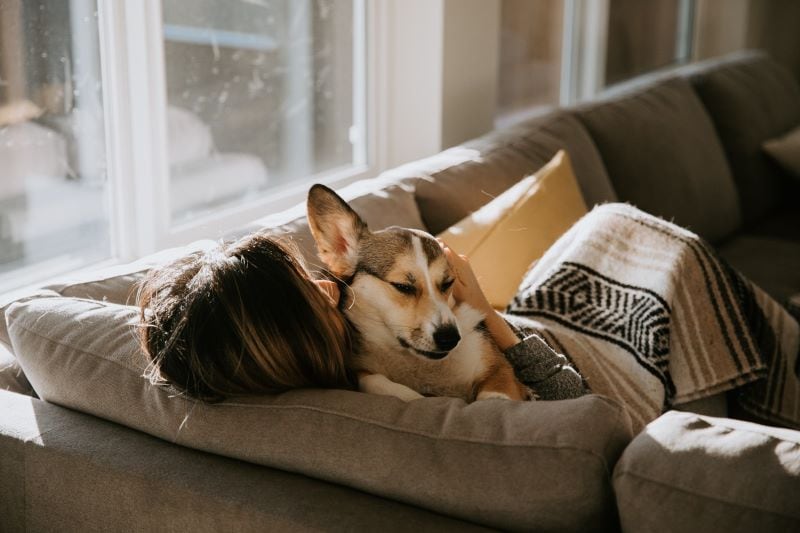Have you recently noticed your furry buddy whining in his sleep? If so, you must be worried trying to figure out this mystery.
Why do dogs cry in their sleep? Your dog may cry, or bark, growl or whimper, in its sleep because it is dreaming. It is believed that dogs go through phases of electrical activity in their sleep, just like how humans do. Your pup is therefore capable of dreaming and even having nightmares.
But guess what? It is not the only reason behind why your dog is crying in his sleep. To give you complete insight, we will discuss some potential causes for this behavior. You will also get your hands on some tips to deal with your dog whining in his sleep. So, take the time to continue reading to find out more.
What Is The Reason Behind Dogs Crying In Their Sleep?

Dogs usually cry while dreaming, but it may also have a severe cause behind it, like a seizure or REM Behavior Disorder.
Let’s discuss each of the reasons in detail to help you understand what your dog is going through to help him out properly.
Dreams
It must sound fascinating to you that dogs are capable of dreaming. This conjecture was derived from studies only known some years ago when scientists monitored brain activity of rats. They compared their brain activity while awake and while asleep, and found both activities to be similar, and it became official that rats and other mammals do dream.
Similarly, your dog dreams just like you do. We will discuss dogs’ sleep cycle further in the article but for now, let’s focus on the signs that indicate your dog is dreaming. For instance, you will notice your pup making noises, crying, or whispering. Other symptoms include irregular breathing or restlessly moving legs.
Now you must be wondering, do dogs have nightmares? Yes, dogs do, in fact, experience nightmares due to their sleep patterns being similar to that of humans. In the next section, we will explore the differences when a dog experiences dreams and nightmares.
Seizure
The way your dog whines, moves, or trembles involuntarily while dreaming is similar to having a seizure. But if you pay attention, there is a considerable difference in the frequency of the movements.
For instance, during a grand mal seizure, your pup’s activities throughout his body will become highly uncontrollable and violent. On the other hand, a petit mal seizure will cause involuntary movements in one part of the body. Moreover, the actions while dreaming lasts for less than 30 seconds, while a seizure lasts longer.
In case of an attack, it is better not to go near your dog or touch him as he will bite you in that state. Just make sure there is no noise around him, and the lights are dimmed. If the seizure goes on for more than a minute, you must reach out to the vet to avoid complications.
REM Behavior Disorder
The REM Behavior Disorder deludes your dog into thinking that whatever he is dreaming about is real. This disorder leads your pup to sleep talking and even walking into stuff, similar to humans. Although this disorder rarely occurs, it can be the reason behind your dog crying in his sleep.
For instance, if your dog is running after someone in his dream, he will struggle to try his best to catch up to him. As a result, your dog’s brain triggers the body to move. However, due to being in a sleeping state, his muscles will make slight movements similar to twitching.
The same goes for your pup crying. If he is hurt badly in the dream, he will probably whimper in reality as well. Sometimes, your dog can get startled enough in his dream to wake up and bump into stuff abruptly.
So, if you suspect your dog has this disorder, you can take him to the vet and get him checked. If your pup is diagnosed with the REM Behavior Disorder, then the vet will develop a plan to counteract this disorder.
How Do I Tell If A Dog Is Having A Dream Or A Nightmare?

You can tell if your dog is having a dream or a nightmare through the signs he shows. For instance, he will twitch and make quiet noises while dreaming. But in case of a nightmare, he will growl, cry, and seem to be restless.
Let’s extend the difference in the behavior of a dog wandering around having fun in dreamland and one running for his life trying to wake up from a horrible nightmare.
Signs Of A Dog Having A Regular Dream
As discussed earlier, your dog will show slight movements like his paws, tail, or ears twitching while making small noises. To add more, you will be able to notice his eyes or eyelids quivering. Moreover, your dog will seem in a peaceful state while sleeping with no signs of stress or uneasiness.
All of these signs will probably mean that your dog is having a pleasant dream and a sound sleep. So, in such situations, you don’t have to worry about anything and just let your pup have his beauty sleep, and you have yours.
Signs Of A Dog Having A Nightmare
While having a nightmare, your pup will behave kind of opposite to having a delightful dream. You can expect some growling along with the rapid movement of eyelids and shuddering paws.
Also, you can hear your pup bark a bit, cry or howl while asleep. These symptoms indicate that your dog is terrified because of something in the dream.
In some cases, dogs even wake up abruptly from deep slumber and look alarmed and disturbed, which means they wake up from a nightmare. It is similar to when humans wake up suddenly from a nightmare late at night, looking all pale, feeling hot, and showered with sweat.
In fact, your pup will have his paws sweating, or a bit damp when he wakes up. The following list captures all the signs we have discussed to give you a brief overview.
- Crying
- Barking
- Howling
- Tense jaws and body
- Sweating
- Quiet noises
- Twitching eyelids
- Heavy and rapid breathing
Understanding The Logic Behind Dogs Having Nightmares
Given that dogs have sleeping patterns similar to humans, they will go through similar sleep stages. The main phases are REM (rapid eye movement) and SWS (slow wave sleep). In order to understand the phase in which your pup experiences nightmares, you will have to know about both these sleep stages.
So, in the SWS stage, your dog’s brain activity reduces, but his muscles and reactions will be just like if he is awake. At this point forth, your dog will transit into the REM stage, where his body will be in a completely relaxed state while having an active mind.
According to studies, your dog will enter the REM phase and start dreaming after falling asleep for around 10 to 15 minutes. It is the stage where your dog will experience nightmares, and they will seem real and vivid. As a result, you get to hear cries or see twitchy paws.
You might be curious about what your dog is dreaming about. Well, dogs dream about their day, the activities they did, or the time they spent with you.
If we talk about the nightmares, it will probably be like your dog getting separated from you or a giant mouse chasing him around. Plus, if a dog goes through traumatizing events, the chances are that he will have nightmares about them.
Should You Wake Up Your Dog From A Nightmare?
You shouldn’t wake up your dog if he is having a nightmare, no matter what. Your pup doesn’t know the difference between dream and reality. So, if you wake him up, he will be too shocked to think straight and may end up hurting you.
Now the question is, if it is bad to wake up a dog having a nightmare, then how should you deal with it? To understand this answer better, let’s look at how much sleep your dog needs.
Dogs’ Average Sleep Time
You will find it unbelievable when dogs sleep half the day for a period of 11 to 13 hours daily. Plus, puppies and senior dogs will require to sleep even more than 13 hours. Now, dogs get cranky and even diseases when they don’t get enough sleep.
When a dog is in the REM phase, he is deep in sleep. So, waking him up in the middle of the night is not a great idea, as your dog will get highly disturbed and may occasionally bite when awakened abruptly.
How To React If Your Dog Has A Nightmare?
No matter how tempting it may look to just wake your whimpering puppy up, you should always wait for him to calm down. After your pup relaxes a bit, caress him slowly for him to take notice of your presence.

Gently call out your pup’s name to help him smoothly come out of REM without any sudden shocks. Just remember to let your dog sleep after his nerves soothe down, as he needs to rest after such a horrible nightmare.
Here are some practical tips that will help deal with your pup having a nightmare.
- Turn on some relaxing music or white noise while your dog is sleeping.
- Diffuse lavender oil to calm anxiety and help relax his mind.
- Make sure your dog’s sleeping area is quiet and dark to avoid disrupting his sleep.
- Get a dog-appeasing pheromone collar to help calm your dog’s nerves.





